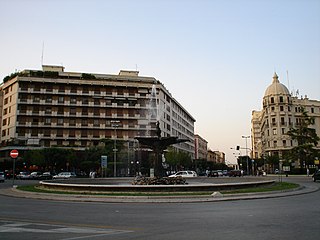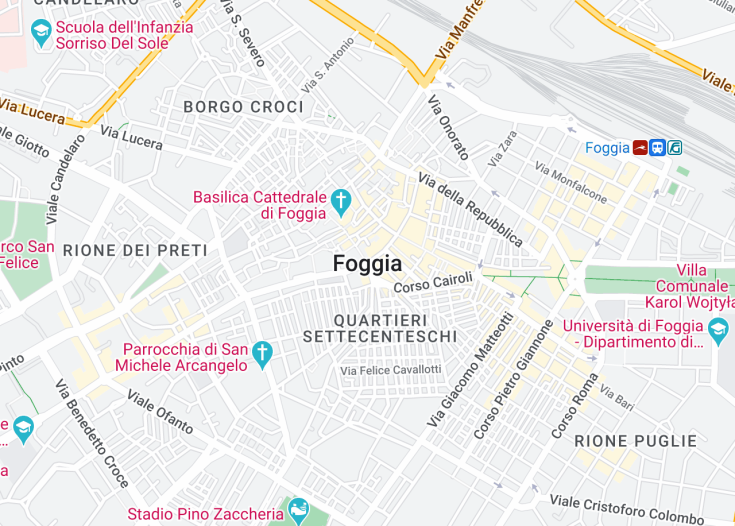Foggia, nestled in the heart of Italy’s Puglia region, offers a unique blend of cultural heritage and natural beauty. This city, rich in history and tradition, serves as a gateway to the picturesque Gargano Peninsula and the sublime beaches of the Adriatic Sea. Visitors can explore architectural marvels like the majestic Cathedral of Foggia, and the historic Palazzo Dogana, which symbolize the city’s storied past. The local cuisine, featuring traditional Pugliese flavors, provides a tantalizing treat for the gastronomically inclined. Foggia’s vibrant local markets and festivals further showcase its lively cultural scene.
Don’t miss a chance to visit the Mercato di Piazza Mercato, a bustling local market where you can sample Foggia’s renowned culinary delights and artisan crafts.
Plan your visit during one of Foggia’s traditional festivals, such as the Festa di San Padre Pio, to experience the city’s rich cultural tapestry first-hand.
Top things to do & see in Foggia
Select the following sights and activities to discover best tickets and tours available in Foggia.
Foggia: A Gateway to Italy’s Past and Present
| Country | Italy |
| Time in Foggia | GMT+1 |
| Language spoken | Italian |
| Population | 151,000 (According to the latest data from Istat) |
| Currency | Euro (€, EUR) |
| Airports |
|
Foggia, located in the Puglia region of southern Italy, offers a blend of rich history and vibrant contemporary culture. This city’s roots can be traced back to ancient times when it was settled by the Daunii, an ancient Italic people. Over the centuries, Foggia has seen the rule of many different empires, each contributing to its architectural and cultural heritage.
Today, Foggia is renowned for its agricultural significance to Italy, often referred to as the “granary of Italy”. The city’s economic mainstay includes the production of wheat, tomatoes, and olives. Moreover, Foggia hosts the annual Festa della Madonna dei Sette Veli, a festival that attracts visitors with its religious processions and vibrant cultural events.
The historical landmarks in Foggia, such as the iconic Cathedral of Foggia (Cattedrale di Foggia), which was rebuilt in the 18th century after an earthquake, the majestic Palazzo Dogana, and the ancient Church of the Cross, add to the touristic charm of the city. Visitors are also drawn to the nearby Monte Gargano and the Forest Umbra, offering beautiful natural landscapes and opportunities for hiking and outdoor activities.
The local cuisine, deeply rooted in Foggia’s agrarian culture, showcases dishes like orecchiette pasta with turnip tops and taralli, which are enjoyed by locals and visitors alike. The warm, welcoming nature of the Foggian people, combined with the city’s historical and natural sites, makes Foggia a captivating destination for those looking to explore the deeper and less-traveled parts of Italy.
Where is Foggia?
Foggia is situated in the southern part of Italy, within the broader Apulia region, known for its coastal landscapes and ancient architectural sites.
Distances:
| Route | Distance by Car | Time by Car |
|---|---|---|
| Rome to Foggia | 200 mi | 3 hours 30 minutes |
| Naples to Foggia | 90 mi | 1 hour 45 minutes |
| Bari to Foggia | 70 mi | 1 hour 10 minutes |
What is Foggia famous for?
Foggia is especially famous for its role in agriculture, dubbed as Italy’s granary, pivotal for its wheat and olive production, and is revered for its ancient, historical architecture and festivals.
History
Prehistoric Times to Roman Era
Archeological findings suggest that the area of Foggia has been inhabited since ancient times, with evidence of Neolithic settlements. Foggia’s strategic location on the Puglian plains made it a noteworthy site even in ancient times. The Roman period marked its first significant phase of development, linking it to a broader network of commerce and military pathways.
Medieval Period: 9th to 15th Century
Dating back to the 9th century, Foggia became prominent under the Byzantine Empire before falling into the hands of the Normans in the 11th century. It was during the Norman rule that Foggia was fortified and experienced a period of economic prosperity. The city’s involvement in agriculture was solidified in the Middle Ages when the House of Anjou promoted the development of agriculture in the area, dubbing it the “granary of Italy.”
Modern Era: 16th Century to Present
In the 16th century, Foggia continued to flourish under Spanish rule, primarily through agriculture and trade. However, it encountered setbacks, such as earthquakes and plagues. The unification of Italy in the 19th century brought about modernization and development, aligning Foggia more closely with the rest of the country. Today, Foggia is renowned for its cultural heritage, historic sites, and vibrant community life, maintaining its role as an important agricultural and commercial center in Southern Italy.
Visit Foggia
What to see and do in Foggia, Italy.
Foggia, often considered the heart of Puglia’s agriculture, boasts a plethora of cultural and historical sites alongside modern attractions. Key landmarks include the Cathedral of Santa Maria Icona Vetere, originating from the 12th century, and the majestic Palazzo Dogana, a symbol of Foggia’s historical role in controlling grain trades. The city also hosts several museums like the Civic Museum of Foggia, showcasing archaeological artifacts and offering insights into the region’s rich history.
- Explore the ancient Cathedral of Foggia
- Visit the Palazzo Dogana
- Stroll through the historical Piazza Pellegrino
- Check out the local art at the Pinacoteca Provinciale
Popular events in Foggia
Foggia vibrantly celebrates its culture and traditions with various events throughout the year. The Foggia Film Festival, held annually in November, attracts cinema enthusiasts with its showcase of national and international films. Another significant event, the Feast of the Patron Saint, St. Alfonso Maria de Liguori, occurs every August, filled with religious ceremonies, cultural activities, and lively street fairs.
Best time to visit Foggia
The ideal time to visit Foggia is during spring (April to June) and early autumn (September to October). These periods offer pleasant weather, conducive to exploring the city’s outdoor attractions and participating in local events without the extreme heat of the Puglian summer.
Is Foggia worth visiting?
Foggia is unquestionably worth a visit for those intrigued by rich history, diverse cultural experiences, and gastronomic delights. The city offers a unique blend of historical heritage and vibrant modern life. Visitors can explore numerous ancient sites, enjoy local cuisine, and participate in traditional events that display the city’s lively spirit and cultural depth.










